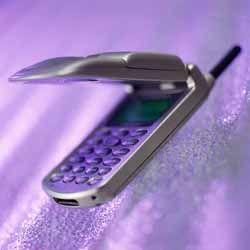Swifter Switching

A collaboration of researchers has flipped micron-sized magnets as quickly as their fundamental speed limit will allow. In two papers published in the 10 January print issue of PRL, the researchers describe applying an ultrafast magnetic field pulse to reverse micromagnets almost as fast as the switching of a bit on a Pentium chip. But unlike silicon circuitry, a magnetic switch preserves data without the need for a constant power supply. The work strengthens hopes that fast and efficient magnetic memory could soon replace technology used in mobile phones and digital cameras.
Storage media such as hard drives and digital tape represent the ones and zeros of data using the orientations of tiny bar magnets: “up” for one value and “down” for the other. The bar magnets are “domains,” each containing many atoms whose net magnetic alignment is called the magnetization of the region. To be useful for memory–rather than longer-term storage–a device must switch between states quickly, efficiently, and reliably.
Today’s hard drives switch an “up” bit by applying a magnetic field pointing down, but the flip is a slow, messy process. As each atomic magnet begins to tilt, it rotates in the perpendicular direction, tracing out a cone that gradually widens and then collapses again as it spirals into a “down” orientation. The motion is like that of a spinning top which starts out vertical but slowly loses energy and traces out wider and wider cones before dropping. This so-called precessional motion wastes energy and time. Additional time is wasted during the flip because the entire domain doesn’t reverse simultaneously–a “wave” of flipping atoms must sweep across the region. Between these two retarding effects, the magnet takes nanoseconds to align, far too long to work as RAM (random access memory).
The most efficient way to flip a micromagnet is to create precessional motion in the vertical direction by applying the field horizontally. This kind of flip wastes little energy and is much quicker for each atom. The technique also reverses an entire domain simultaneously. But the field has to be turned on and off rapidly to achieve exactly one 180-degree rotation, and the technology for such short magnetic pulses has only recently become available. Several research teams have worked to achieve this fast, efficient switch, but no one has shown entirely convincing evidence for it.
Hans Schumacher of the National Center for Scientific Research (CNRS) in Paris and his colleagues used a spin valve to measure reversal of a single magnetic “bit.” The electrical resistance of the device depends upon the magnetic alignment of a 2- by 4-micron region of a cobalt-iron-nickel mixture. In their first paper, the team describes applying field pulses of varying lengths. As the pulses got longer, the magnetization first became reversed, then returned to its original orientation, then reversed again, periodically. The 300-picosecond period of this signal matched the time the researchers expected for a complete revolution of the magnetic atoms and appeared to confirm that the switching occurred by precessional motion. In the second paper they follow the magnetic rotation in “real time” throughout one 180-degree flip and conclude that a single, 165-picosecond reversal is at the limit of speed and energy efficiency.
“This is beautiful physics,” says Roger Koch of IBM in New York. “The plots are textbook and really convincing.” But Koch says there are still some very difficult technical problems with magnetic RAM that arise when the cells approach the nanosize of today’s silicon processors. So we are likely to see precessional magnetic switching used for phones and cameras in the near future, rather than for RAM in computers, says Claude Chappert of CNRS, who supervised the work. These applications do not require such small chips but could benefit from the efficiency and speed of magnetic switching.
–Celeste Biever
Celeste Biever is a freelance science writer in San Francisco.


